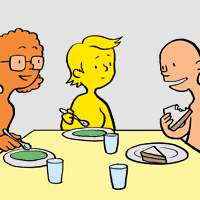One of the many ‘non-traditional’ uses of Talking Mats has been the work that has been undertaken with university students (both undergraduate & post graduate) at the University of Stirling. Since 2008, staff in the Career Development Centre at the University have been trained to use Talking Mats as a tool to help students to articulate their career thinking and planning.
We have established from our research and trialling of a range of topic cards that students respond well to the process. While the majority of the students we work with have no speech or language difficulties, the process of TM enables students to articulate their thoughts and to feel more at ease to raise particular issues. It can be very hard for students to talk openly about financial worries, academic issues, or career anxiety. TM gives a platform for this to be done in a non-threatening way and quickly allows the Careers Adviser to see where the student is ‘at’ in their thinking. This then allows the adviser to work more efficiently & effectively to support the student to develop their career plans /strategy.
Staff feedback would indicate that they enjoy working with TM in both one to one and group settings with students. There are many perceived advantages to using TM but one of the main ones is that it can make better use of the time available and that it can be a good way to see quickly where the key issues are that need to be addressed. TM also fits well with current Career Guidance Theory, allowing the student to narrate the ‘story’ and arrive at their own solutions to the ‘problem’ under discussion.
There are of course some students who do have additional learning needs and TM is again an ideal tool. In particular, students with dyslexia and dyspraxia comment positively that the visual aspect of the cards allows them to process the information and structure their thinking in a clearer way that just talking to a careers adviser can.
International students who sometimes have poor English language skills respond well to using TM as it allows us to get a clearer picture of the students thinking than sometimes is the case from a more ‘traditional’ discussion
Action Planning and Goal setting are a big part of the Career Management process and TM is a really useful tool to ‘kick-start’ this process for students. The visual impact is powerful and enables students to see clearly what they are considering and the cards allow the students to physically move the cards to help them to decide how to move forward in their thinking and planning. Students consistently comment that they appreciated the opportunity to see clearly the issues that they are considering and allow them to move forward.
Many thanks to Elaine Watson, Careers Adviser, University of Stirling and one of our accredited trainers for this stimulating description of how she is implementingTalking Mats
It is recognised that it is difficult for people with communication disability to give feedback to health service staff. The group that developed the Making communication even better resource decided that mystery shopping would be a good way to find out whether health staff were supporting their communication and enabling them to access the services that they require and are entitled to. Funding was sought and gained from NHS Education Scotland for a small mystery shopping project.
20 people with communication disability were involved in the project which was coordinated by Talking Mats Limited and the Stroke Association Scotland. There were different aspects of the project – making phone calls, face to face visits and recounting personal experience . It covered the 14 Health boards in Scotland. The project report was named ‘Through a Different Door’ as this reflected the overall findings that people had highly varied experiences of interactions with health service staff ranging from the excellent and supportive to poor which had the further risk of endangering patient safety . Click here to read the final reports
Whilst developing the eating and drinking resource, we tried it out with people with a range of eating and drinking difficulties. I talked to Ellie, who had swallowing difficulties following a stroke. She found it really helpful to use the mats to think about different aspects of meals (mealtimes, where you eat and the process of eating). Ellie had very good insight into her eating and drinking difficulties and had developed clear strategies to help manage them. She found breakfast and snacks the most difficult meals to manage. She was also very clear that pureed and soft moist foods were the safest and easiest for her. After we had done the mat, Ellie reflected on her eating and drinking, saying that it was limiting but that she could see that things had improved. One of the most difficult things for her was the impact of her swallowing difficulties on some of the social aspects of eating. She really misses going out for a meal with family and friends, something that we often take for granted.
Doing the ‘meals’ mat helped Ellie to see that although she still has many difficulties, mealtimes have become less stressful. For example, although eating and drinking is still a long, slow process, Ellie and her family have adapted to this and now manage ok, especially if they plan ahead. Some useful action points were also identified for the professionals working with Ellie – it would be good for her to have suggestions about a greater range of breakfast options as well as a variety of snacks which she could eat between meals.
Using the mats really helped to clarify the progress that Ellie has made with her eating and drinking since her stroke.
View the images used in the resource by downloading this short selection
To order your copy of the resource click here The resource will be available on our digital Talking Mat shortly
 Online training login
Online training login 




